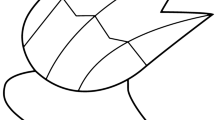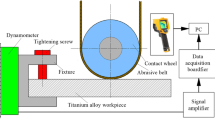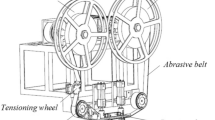Abstract
This paper proposes a down-stroke abrasive belt grinding under micro feeding for noise reduction surface. Firstly, a physical model of processing under micro feeding for noise reduction structure was established. Based on the flexible contact characteristics of abrasive belt grinding and Hertz contact theory, a mathematical model suitable for this method was established, considering vibration and abrasive belt wear. Secondly, a simulation analysis was carried out. Then, an experimental platform was built to analyze the influence of process parameters on surface roughness and surface microstructure, with the model verified. Finally, the propeller with pit structure was simulated, and the noise reduction performance of the propeller under this method and general abrasive belt grinding was compared and analyzed. The results show that the maximum error of the model based on proposed method does not exceed 10%, and the coincidence degree of the minimum error point can reach 90% at lower feed speed and higher linear velocity of the abrasive belt. The noise reduction effect of the propeller with pit-shaped surfaces can reach 35%. Through the above analysis, the proposed method can be used for the processing of noise reduction surfaces.
Similar content being viewed by others
References
Xie J B, Zhou Q D. The effect of stern on the propeller tone noise. Ship & Ocean Engineering, 2010, 39, 17–20.
Wei Y M. The Progress of the researches on the marine underwater noise in China. Shanghai Shipbuilding, 2000, 01, 27–32. (in Chinese)
Wang S J, Ren L Q, Han Z W, Qiu Z M. The effect of non-smooth of being creatures and its bionic applied research. Journal of Agricultural Mechanization Research, 2005, 01, 209–210+213. (in Chinese)
Zhang B C, Li Z. Experimental study on grinding propeller with diamond belt. Diamond & Abrasives Engineering, 2020, 40, 21–24.
Xiao G J, Song K K, Liu S, Wu Y, Wang W X. Comprehensive investigation into the effects of relative grinding direction on abrasive belt grinding process. Journal of Manufacturing Processes, 2021, 62, 753–761.
Ou L J. Research and application of acoustic processing of ducted propeller. Guangdong Shipbuilding, 2020, 3, 16–18. (in Chinese)
Mulcahy N L, Croaker P, Mcguckin D G, Brandner P A, Kessissoglou N. Optimisation applied to composite marine propeller noise. INTER — NOISE and NOISE — CON Congress and Conference Proceedings, Hong Kong, China, 2014, 4012–4019.
Wang L, Yan Q, Xue D W, Wei K. Experimental investigation on noise reduction of double rotating propellers. Equipment Environmental Engineering, 2019, 7, 18–22.
Ma C, Qian Z F, Chen K, Cai H P. Research on performance of a new-type low-noise multi-blade coupling propeller. Journal of Ship Mechanics, 2014, 8, 889–897.
Yang C Q, Huang Y, Wu J Q. Experimental research on surface quality of marine propeller in belt grinding. China Mechanical Engineering, 2011, 22, 1659–1663.
Wu M J. The development trend of CAD/CAM/CIM shipbuilding software in the world. Ship & Boat, 1999, 05, 41–44.
Zhang N H, Li S X. Recent Development of Belt Grinding Technology. Agricultural Equipment & Vehicle Engineering, 2009, 10, 50–52.
Xi X X, Ding W F, Wu Z X, Anggei L. Performance evaluation of creep feed grinding of γ-TiAl intermetallics with electroplated diamond wheels. Chinese Journal of Aeronauics, 2021, 34, 100–109.
Li B K, Dai C W, Ding W F, Yang C Y, Li C H, Kulik O, Shumyacher V. Prediction on grinding force during grinding powder metallurgy nickel-based superalloy FGH96 with electroplated CBN abrasive wheel. Chinese Journal of Aeronautics, 2021, 34, 65–74.
Li B K, Miao Q, Li M, Zhang X, Ding W F. An investigation on machined surface quality and tool wear during creep feed grinding of powder metallurgy nickel-based superalloy FGH96 with alumina abrasive wheels. Advances in Manufacturing, 2020, 2, 160–176.
Zhang W C, Duan S L, Wu J. Transmission path analysis and noise reducing of ship propeller lateral vibration based on Statistical Energy Analysis (SEA). Ship Engineering, 2016, 11, 47–57+77. (in Chinese)
Huang Y, Jiahua S L, Xiao G J. Bionic surface abrasive belt grinding of nickel-aluminum bronze alloy and its noise reduction characteristics. China Mechanical Engineering, 2020, 20, 2497–2504+2511. (in Chinese)
Wen L, Weaver J C, Lauder G V. Biomimetic shark skin: Design, fabrication and hydrodynamic function. Journal of Experimental Biology, 2014, 217, 1656–1666.
Zhao D Y, Li T, Wang M J, Guo C F. Replication process of micro-electroforming of sharkskin micro-structure. Die & Mould Industry, 2014, 40, 52–55.
Wei Y L, Xu F, Bian S Y, Kong D Y. Noise reduction of UAV using biomimetic propellers with varied morphologies leading-edge serration. Journal of Bionic Engineering, 2020, 17, 767–779.
Ikeda T, Ueda T, Nakata T, Noda R, Tanaka H, Fujii T, Liu H. Morphology effects of leading-edge serrations on aerodynamic force production: An integrated study using PIV and force measurements. Journal of Bionic Engineering, 2018, 15, 661–672.
Fan S S, Zhou H C, Chen L. Noise reduction analysis of dimpled bionic tire pattern. Science and Technology Innovation Herald, 2015, 12, 60–61+64. (in Chinese)
Liu J C, Chen E Y, Yang A L, Li G P. Study on noise reduction characteristics of blade with non-smooth surface. Journal of Engineering for Thermal Energy and Power, 2020, 35, 31–39.
Liu J, Kagawa T. Computational aeroacoustics simulation of an air micro-injector with dimples shape on the surface of divergent nozzle. IOP Conference Series: Materials Science and Engineering, Chengdu, China, 2017, 012009.
Yoshikazu K, Koichi M, Nobuyuki I, Masafumi O. Optimization of additional dimple based on the objective function of the distance between nodal line and driving point for noise reduction of thin plate. The Proceedings of the Dynamics & Design Conference, Tokyo, Japan, 2005, 20–25.
Hirt G, Thome M. Rolling of functional metallic surface structures. CIRP Annals — Manufacturing Technology, 2008, 57, 317–320.
Denkena B, Köhler J, Wang B. Manufacturing of functional riblet structures by profile grinding. CIRP Journal of Manufacturing Science and Technology, 2010, 3, 14–26.
Ivanov T, Bührig-Polaczek A, Vroomen U, Liu J C. Casting of microstructured shar skin surfaces and applications on aluminum casting parts. Foundry, 2011, 60, 229–232.
Wan L, Li X, Zhu N, Mei T. Optimization for etching shallow ridge and trench profiles on silicon based on continuous etching process in ICPRIE system. Microsystem Technologies, 2016, 22, 2133–2139.
Yang H L, Zheng Y, Wang Y. Bio-tribology properties of imitation shark skin morphology on Ti6A14V surface. Hot Working Technology, 2016, 45, 119–122.
Shao J P, Xu B. Creative design and vibration experimental study of multi-speed polishing machine. Journal of Vibration and Shock, 2012, 31, 110–114+150. (in Chinese)
Li Z, Wang X R, Fu X F, Li J W, Li J S, Zhou Y D. Large-pitch screw vibration characteristics analysis and vibration suppression method. Journal of Harbin University of Science and Technology, 2020, 25, 40–47. (in Chinese)
Hou B, Wang Y Q, Wang F B, Ji Z C, Liu H B. Research on belt grinding for marine propeller blade based on the second-order osculation. The International Journal of Advanced Manufacturing Technology, 2015, 80, 1855–1862.
Huang Y, He S, Xiao G J, Li W, Jiahua S L, Wang W X. Effects research on theoretical-modelling based suppression of the contact flutter in blisk belt grinding. Journal of Manufacturing Processes, 2020, 54, 309–317.
Xiao G J, He Y, Huang Y, Li Q. Shark-skin-inspired micro-riblets forming mechanism of TC17 titanium alloy with Belt grinding. IEEE Access, 2019, 7, 107636–107647.
Fan W G, Wang W X, Wang J D, Zhang X L, Qian C, Ma T F. Microscopic contact pressure and material removal modeling in rail grinding using abrasive belt. Proceedings of the Institution of Mechanical Engineers, 2021, 235, 3–12.
Acknowledgment
This work was supported by National Natural Science Foundation of China (U1908232), National Science and Technology Major Project (2017-VII-0002-0095), Graduate scientific research and innovation foundation of Chongqing (CYB20009), China Postdoctoral Science Foundation (2020M673126), Natural Science Foundation of Chongqing (cstc2020jcyj-bshX0128).
Author information
Authors and Affiliations
Corresponding author
Rights and permissions
About this article
Cite this article
Liu, Y., Song, S., Xiao, G. et al. The Method and Experiment Research on Down-stroke Abrasive Belt Grinding under Micro Feeding for Noise Reduction Surface. J Bionic Eng 18, 958–973 (2021). https://doi.org/10.1007/s42235-021-0054-7
Published:
Issue Date:
DOI: https://doi.org/10.1007/s42235-021-0054-7




